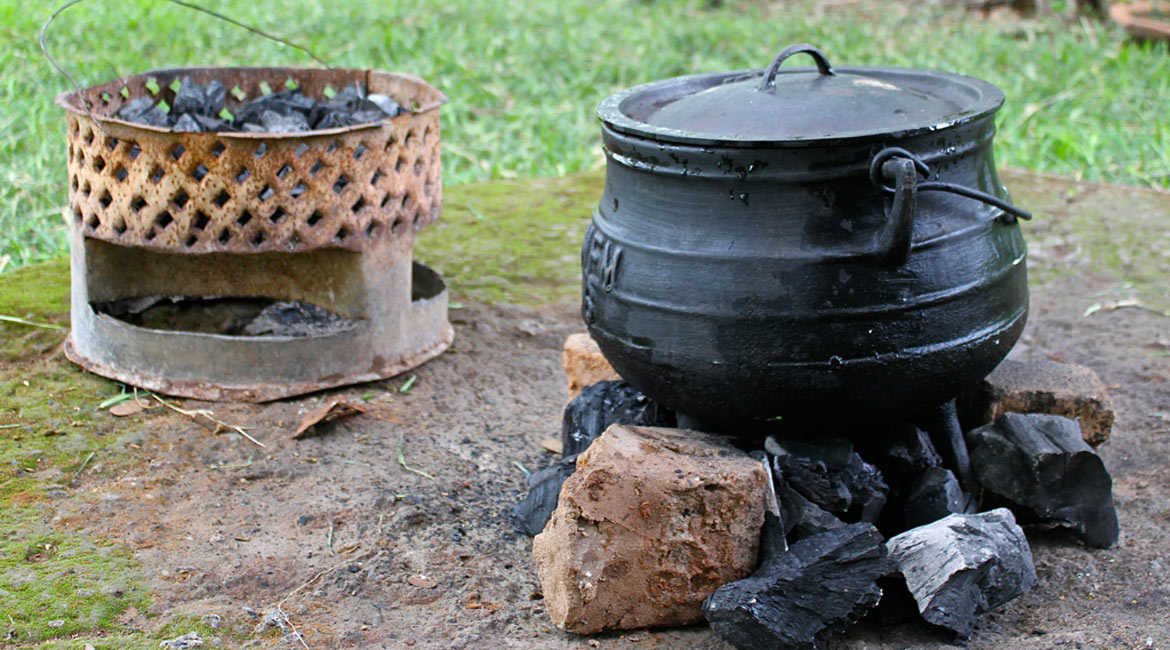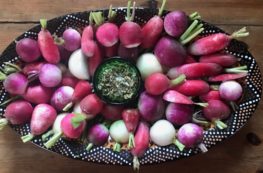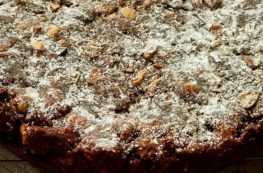I love learning. I especially love learning new things about ethnic food. The other day I stood by and watched as Adelina Banda and her assistant, Otiria Ngoma, prepared our first traditional Zambian lunch for 19 people. I had been asked by a German NGO, working on an HIV advocacy program in Livingstone, to host a celebratory workshop and lunch for its staff, facilitators, and key stakeholders.

One of Zambia’s most beloved traditional dishes is ifisashi: pumpkin leaves cooked with groundnuts (peanuts). The day before the lunch, Adelina crushed the groundnuts in a giant wooden pestle and mortar. Afterwards, she sifted the crushed nuts through a sieve until she had a fine powder.

Seasoning the saucepan with salt first, she added the chopped pumpkin leaves and cooked them for 10 minutes. She later added two cups of groundnut powder and three cups of water. She simmered the mixture for 45 minutes, cooled it, and then left the ifishashi to sit outside overnight. An hour before the lunch, it was warmed up in the oven to be served as a side dish.

The day before Adelina and Otiria also prepared the munkoyo, a slightly fermented non-alcoholic drink made from maize and the native munkoyo root, harvested from a tree bearing the same name. The drink is ubiquitous throughout Zambia, and bundles of battered munkoyo roots can be found in markets up and down the country. We bought ours at the local market in Livingstone.

While Adelina soaked the munkoyo roots in two liters of water, Otiria boiled hand-ground maize called masembe — a kind of arborio rice lookalike — over a fire for a couple of hours. Once the masembe had cooled to room temperature, they mixed in the munkoyo roots with a small amount of maizemeal porridge, the latter of which was used as a thickening agent. They left the drink to ferment outside overnight, like they did with the ifishashe. Just before serving, they added half a cup of sugar to the five liters of munkoyo.

Adelina prepared the nkunku, or chicken pieces, by browning and then frying them in vegetable oil. She added a relish she had made with tomatoes and onions taken from our garden, and simmered them together for a further 20 minutes. Otiria, meanwhile, cooked the nshima, a maizemeal porridge similar to grits, in a huge cast iron pot over the open fire.

Nshima is Zambia’s staple food, and is usually part of every meal. I have heard it’s a real art cooking nshima: it can’t be too stodgy, and it can’t be too wet. In Zimbabwe, where I grew up, the maizemeal porridge was called sadza. I loathed it. I had been put off eating sadza at boarding school, where artful cooking was never a priority, and I have never really managed to acquire a taste for it since. The ifisashi on the other hand was unusual and flavorful. There is little I can compare it to other than a peanut butter-laced creamed spinach. It was popular at the lunch: nearly everyone asked for a second helping.

Daniela Rudner, a German national, has overseen the HIV advocacy program in partnership with her government for the past two years. At the end of November the first phase of the program ended. Daniela organised the lunch because she not only wanted to recognise the success of her Zambian facilitators, but provide an opportunity for them to network with board members of Zambia’s Department of Education, a key stakeholder in the next phase of the program.

Six work stations were set up under the trees outside our lodge for different facilitators to showcase their HIV advocacy to the stakeholders. This involved group participation via storytelling, play acting, props, and drawing boards.

Lunch was served under the trees after the presentations were completed. Adelina and Otiria’s traditional Zambian lunch was followed by champagne, and a chocolate cake made by me, to celebrate new beginnings. They also raised a glass to say farewell to Daniela, who is leaving Livingstone this month. Bon voyage!






14 Comments
Photos. & story wonderful as usual.
Thank you very much, Kathy! I loved putting this post together … xo
I always learn something interesting here. And “peanut butter-laced creamed spinach”? Bring on the ifisashi!
Thank you, Michelle! It was a learning curve for me, too, which I loved. All the best to you … Annabel
Wow…thanks for sharing the learning experience! Well done to Adelina and Otira for a delicious looking meal. I love the way the Nshima has been formed into balls for serving. A real art to getting it the right consistency I’m sure.
Thank YOU for your interest, Hellie! They both did such a wonderful job. I overheard one of the participants saying to a colleague how he planned to come back here for his wedding! 🙂
Love this. Dad would have been so proud of the work being done – and the perfect feast and setting to celebrate all that.
Your dad, THE pioneer in HIV advocacy, would have enjoyed it, Georgie. I have such fond memories of him accosting me in Mvurwi village with a huge box of condoms, insisting I take it to pass on the contents to our farm workers! What a man Peter was. I like to think he was with us in spirit … xo
Oh SavannaBel! if only the fare at the elderly farm workers (mostly from Malawi and Mozambique as opposed to Zambia) Christmas party I have just come back from, had been food from the land like at your party! I am sure they would have recognized the recipes and just loved it. As would we!
Hello Carrie … thank you for not only stopping by my blog, but also for the follow. I so appreciate your kind comment, but am most interested to know where your lunch took place? I learned so much cooking with my Zambian assistants, and the food was really delicious. Happy holidays to you wherever you are! Annabel
[…] Otiria Ngoma preparing nshima for our first traditional Zambian lunch. […]
[…] Panna Cotta with Seasonal Strawberries & Baby Meringues Munkoyo is a wild root, which the Zambians ferment with masembe, or pounded maize, to make a traditional drink. It’s […]
Posh review. Great photos. The food looks very appetizing. Thank you so much!
http://confiduss.com/en/jurisdictions/zambia/culture/
Thank you!
Comments are closed.